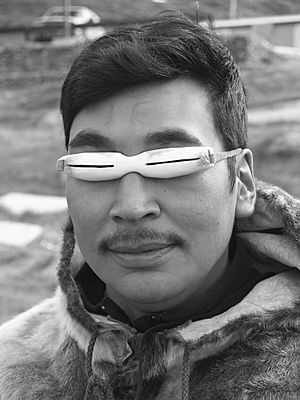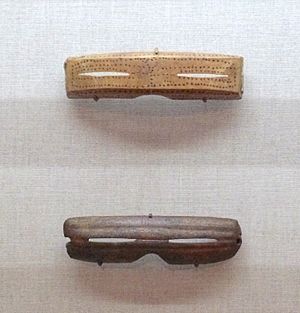Snow goggles facts for kids
Snow goggles are special glasses traditionally used by the Inuit and Yupik peoples who live in the cold Arctic regions. Their main job is to stop a painful eye problem called snow blindness. This happens when your eyes get too much bright light from the sun reflecting off snow and ice.
These goggles are usually made from materials found in the Arctic. People use things like driftwood (especially spruce wood), animal bone, walrus ivory, or caribou antler. Sometimes, they even use strong seashore grass.
The person making the goggles carefully carves the material to fit snugly on their face. This tight fit is important so that no extra light can sneak in around the edges.
How Snow Goggles Protect Your Eyes
The most important part of snow goggles is the narrow slits carved into the front. These slits let in only a small amount of light. Sometimes, people even put soot (like from a fire) on the inside of the goggles. This helps to reduce the glare even more.
The slits are made very narrow for two main reasons. First, they greatly reduce the amount of bright light reaching your eyes. Second, they actually help you see more clearly, especially in bright, flat snowy landscapes. Even though the slits are narrow, they still let you see enough of your surroundings. If the slits were wider, you would see more, but your eyes would also get more glare.
Different Names for Snow Goggles
Just like many words in Inuit languages, the name for snow goggles can change depending on the dialect. For example, in the Kivalliq dialect, the word is ilgaak (written as ᐃᓪᒑᒃ). But in the North Baffin dialect, people say iggaak (written as ᐃᒡᒑᒃ). Both of these words can also mean "sunglasses."
In other languages, like Central Yup'ik, snow goggles are called nigaugek. In another Yupik language called Cup'ig, they are known as igguag. And in Siberian Yupik, the word is iyegaatek.
See Also
- Pinhole glasses



